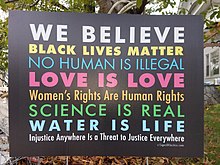This is an old revision of this page, as edited by 79.140.223.93 (talk) at 20:03, 9 November 2020 (Changed some weird, clearly biased phrasing in the article that would seem to be from a right wing perspective, and not reflective of an encyclopedic entry). The present address (URL) is a permanent link to this revision, which may differ significantly from the current revision.
Revision as of 20:03, 9 November 2020 by 79.140.223.93 (talk) (Changed some weird, clearly biased phrasing in the article that would seem to be from a right wing perspective, and not reflective of an encyclopedic entry)(diff) ← Previous revision | Latest revision (diff) | Newer revision → (diff)
In 2020 many issue-based yard signs emerged in neighborhoods across the United States supporting multiple left-wing movements commonly with a Black Lives Matter theme. Stemming from the original "Kindness is everything" sign with the introductory line “In this house, we believe:” many iterations begin more succinctly “We believe” after which a list of movements is enumerated often starting with Black Lives Matter. An even stack of colored lines of correlated phrases stand in vibrant contrast to one another against a black background.
In big cities especially, partisan political signs for the 2020 election have largely been passed over in favor of social justice signs. The Kindness is Everything sign originated as a white woman's show of opposition to Trump on his first day in office.
References
- ^ Kristian, Bonnie (31 July 2020). "America's new yard sign discourse". The Week.
- Bologna, Caroline (8 March 2017). "'Kindness Is Everything' Signs Promote Love In Response To Hate". The Huffington Post.
- Kristin, Joiner. "Kindness is Everything". kristinjoiner.com.
- Taylor, Chris (16 June 2020). "How one woman's yard sign became a rallying cry for allies". Mashable.